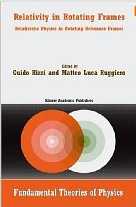Guido Rizzi (Books)
The absolute character of rotation is well known since the very beginning of the modern scientific era. Some experimental evidence, such as Foucault's pendulum and the Sagnac effect, are indeed conclusive. This absolute character is easily understood in the framework of Newtonian physics, but it sounds puzzling in the framework of relativistic physics. The debate pertaining to the relativistic approach to rotation started just after the publication of Einstein's theory, and it is still ongoing. This discussion has stimulated the development of relativistic physics for a century: it deals with many stimulating - and sometimes paradoxical - issues, and encompasses also issues pertaining to the very foundations of relativity. However, understanding the peculiarity of a rotating frame of reference is not of theoretical significance only, but also of great practical significance, since we do live in a rotating reference frame: for instance, the fast development of technical devices, such as the Global Positioning System, requires highly precise measurements that cannot neglect the relativistic effects deriving from Earth's rotation. As a matter of fact, rotation in relativistic physics is quite ubiquitous, since its effects are of great importance in the fundamental processes of length and time measurement, in the synchronization of standard clocks, in the definition itself of space and time, in astrophysics, in the study of quantum systems. Even if the subject is a long-standing one, this is the first monograph on this field. On the one hand, this book is intended to give a rather wide review on this field, both in a historical and pedagogical perspective; on the other hand, it aims at critically re-examining and discussing the most controversial issues. For instance, according to some authors the celebrated Sagnac effect is a disproval of the theory of relativity applied to rotating frames; according to others, it is an astonishing experimental evidence of the relativistic theory. In order to give the reader a deeper insight into this research field, the contributing authors discuss their opinions on the main subjects in an enthralling virtual round table: in this way, the reader can get a direct comparison of the various viewpoints on the most controversial and interesting topics. This is particularly expedient, since the differences in the various approaches are often based upon subtleties that can be understood only by a direct comparison of the underlying hypotheses. This book should be a guide and a reference for all those who, now and in the future, have an interest in this field. In particular it addresses research workers and specialists in relativistic physics, foundations of physics, history and philosophy of science, mathematical physics.



